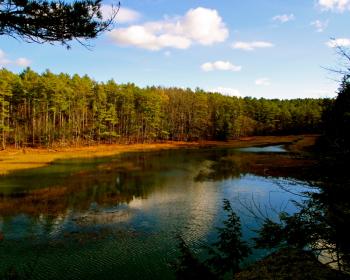Ovens Mouth Preserve, Boothbay
Just before we got our first real taste of winter, we hiked the Ovens Mouth Preserve in Boothbay. Since our visit, it’s snowed — twice in fact!
Like the other preserves and land trusts we’ve featured, the Ovens Mouth Preserve is open year-round. If the snowy weather and freezing temperatures continue, we’ll soon be back to snowshoeing.
Ovens Mouth, a part of the Boothbay Region Land Trust, is on a peninsula. If you could see the preserve from high in the sky, it would look somewhat like a lobster claw, rather fitting for the Boothbay region.
There are two halves of the 146-acre preserve to hike, each with its own entrance. They’re linked together by a striking footbridge spanning a wide tidal inlet.
The entire trail system is over three miles long. It can be hiked in one visit. We chose to do it on separate days, starting with the shorter and much easier “Eastern Shore Loop.” The entrance and parking area for it is off Dover Road.
There are two interlinking trails here. The main one, blazed white, skirts the shoreline, while the other, blazed yellow, follows an old tote road and takes you through the woods. The road gradually runs uphill to a height of 50 feet, according to a topographical map. At the top where it flattens off, you’ll see the foundation stones of an early home site on the left.
Years ago, this spot must have offered a nice view of the water, but today the trees have grown up. Just before you reach the home site, you’ll notice what appears to be a small weep spring in a ring of rocks.
Following the shoreline trail takes you along the Cross River. At its northernmost point is the narrow channel known as “Ovens Mouth” separating Boothbay from Edgecomb. From here, the path loops back to the parking area. Along the way, you’ll see the bridge that carries you to the preserve’s western half.
The parking area for the western half is off Dover Cross Road. There are several trails here; the “Shore Loop” at 1.75 miles is the longest. Blazed white, it starts and finishes at the kiosk and wraps around this half of the peninsula.
We took the western route that starts on the left. It carries you through the forest over a series of small hills and gullies. Along the way, you’ll see a large boulder, a likely “glacier erratic” as my hiking companion pointed out.
The path abruptly turns north and rises, overlooking a gurgling stream that widens into a small inlet from the Cross River. The trail narrows considerably here and was slippery in spots from the recent rainy weather, so watch your footing. This time of year, it’s best to wear hiking boots and carry along a hiking stick. As you near Ovens Mouth, you’ll see high cliffs that form a barrier on the Edgecomb side of the water.
There are a number of stories about how Ovens Mouth got its name. One of the popular ones is that the early English settlers thought the deep-water channel surrounded by high cliffs resembled a baking oven. You might be interested to know there’s a bend in the road in Saltfleetby, Lincolnshire, England that’s known as “Ovens Mouth Bridge,” Ovens Mouth being spelled the same, with no apostrophe before the “s.”
The trail from the Ovens Mouth Preserve footbridge rises sharply uphill. A fine scenic vista awaits at the summit. We spent 90 minutes on this side of the preserve, stopping a number of times for picture-taking.
To visit the preserve from Route 27 headed to Boothbay Center, take Adams Pond Road on the left by the Cottage Connection, and then the first right onto Dover Road. This brings you to the eastern entrance of the preserve (approximately 2.4 miles). Bearing left on Dover Cross Road takes you to the preserve’s western entrance. To learn more, visit www.bbrlt.org.































